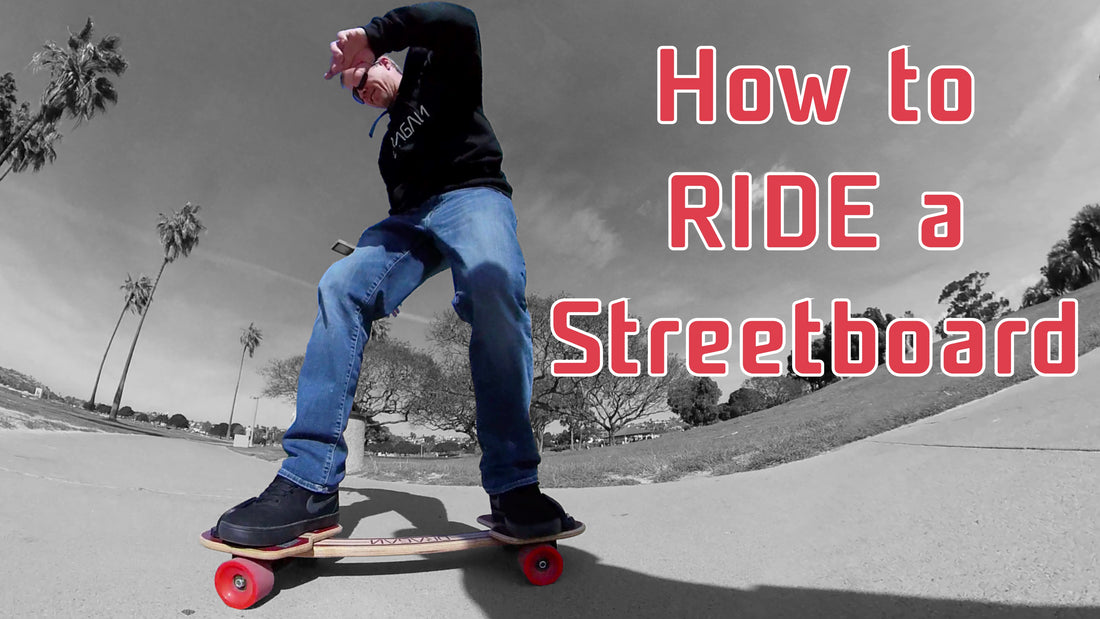Learning to Streetboard is a brain teaser at first. In this tutorial you will learn the two simple movements that will get you up and riding in no time.
Practice makes perfect and after a short session on the board, you'll have mastered the unique movement and be ready to cruise across town, hopping curbs powering up hills and pulling deep carves on the way back down. All without taking your feet off the board.
Step One - Choosing your Location
- The first step to learning how to streetboard is practicing the movements without the board.
- You want to choose a smooth flat area, ideally without many people around for taking your first steps. Please ensure you wear necessary protective equipment and that children are supervised.
Step Two - Working out your stance
- In all boardsports you will either ride with your right foot forwards which is called Goofy Stance, or you will ride with your left foot forward which is called Regular Stance.
- To decide which pretend that you are falling forwards (or have someone give you a light push). Whichever foot you instinctively put forward to stop yourself will be the one you want to lead with.
Step Three - The Crunch
- Before Stepping on the board first practice this movement on the ground.
- It can be split into two separate movements:
- The first is toes together, this is very important. Point your toes inwards so they are pointing at the opposite toes.
- Its now time to bring in your upper body, this is what will drive your streetboard forwards.
- You want to take your leading arm and reach back across your body, like you are buckling up your seat belt, to the trailing hip.
Step Four - The Open
- The second movement to practice on the ground is the open.
- Your feet go from toes together, to toes apart. so they are pointing in opposite directions.
- Its this movement that may at first feel slightly unnatural, as your brain automatically wants to move your feet parallel with each other.
- With your upper body you will now want to "unbuckle your seatbelt" in an exaggerated fashion.
- Your leading arm will go from your trailing hip up and across your body and pointing in the direction of travel.
- You now want to practice a few times going from the crunch to the open position, focusing on ensuring your upper body and feet are moving in unison.
Step Five - Riding a Streetboard
- Now that you have the movements down its time to take them onto your Streetboard.
- To get on a Streetboard the best way is to place your leading foot first, then quickly your second foot. This will stop the board from slipping away from you.
- Next practice the movement with your feet only. This well reenforce the movement as well as help your body get used to the balance on a board.
- Finally its now time to link them together and start Streetboarding.
- Start with the crunch: Toes together and leading arm back across at your trailing hip.
- Then as you swing your arm out to the direction of travel at the same time as opening your toes, you should start to move forwards and turn towards your heel edge.
- You then want to complete the movement by swinging back from the open position to the crunch position.
- Your arm coming back across your to buckle your seatbelt as your toes turn back to face each other.
- A common problem is that you put more effort behind the moving from crunch to open than you to from open to crunch, and end up going in circles.
- To counteract this ensure you are putting as much energy into the open to crunch phase as you are the crunch to open.
That's it, you're Streetboarding. Once you get the flowing motion, you will see why the original brand named it Snakeboarding. We recommend after you have the movements down, spending 15-20 minutes a day, rather than 1 hour a week, over the first couple of weeks. This will help your brain "hardwire" the movements. Once you have learnt how to move a Streetboard, the next skill to learn is how to stop.

